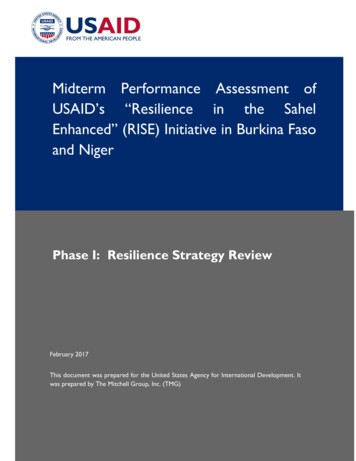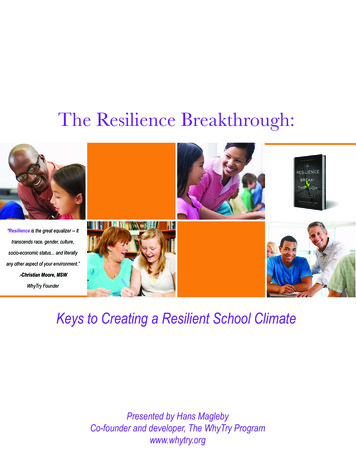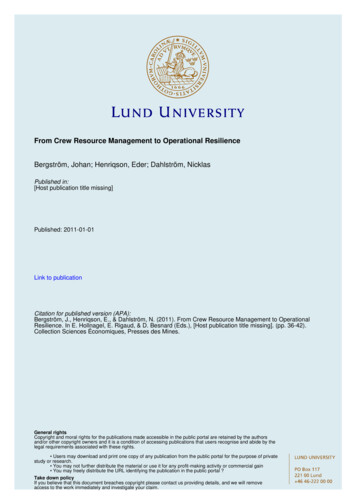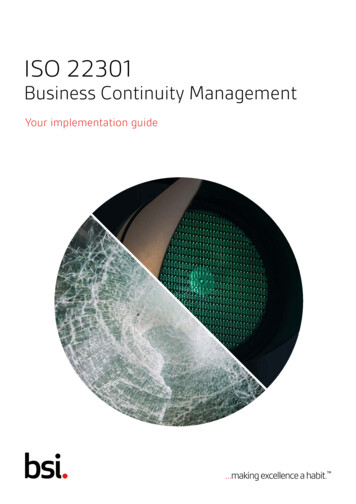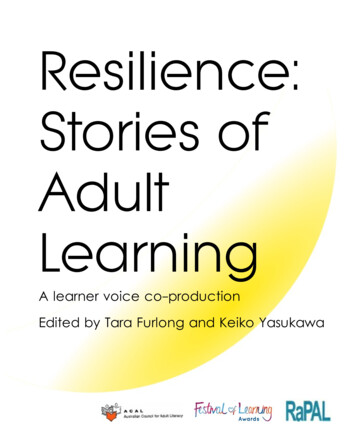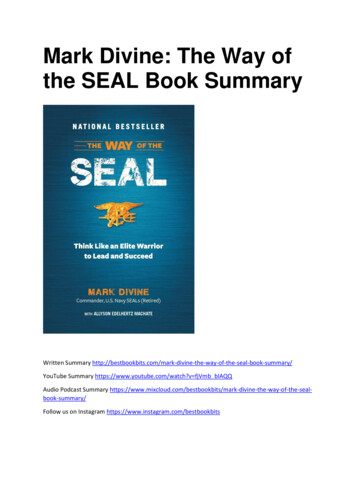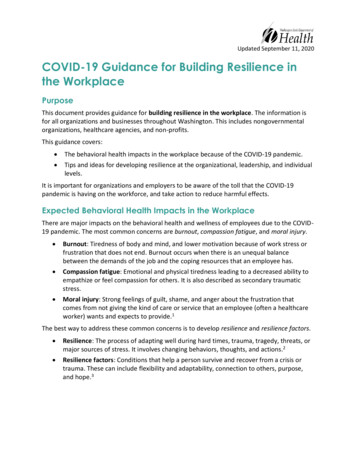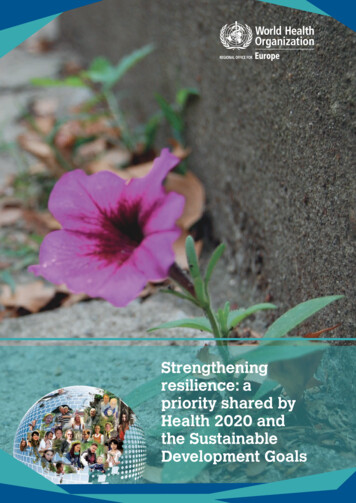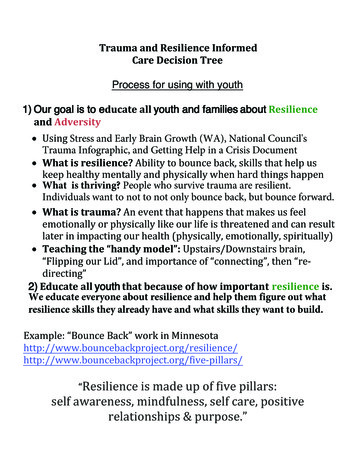
Transcription
Trauma and Resilience InformedCare Decision TreeProcess for using with youth1) Our goal is to educate all youth and families about Resilienceand Adversity Using Stress and Early Brain Growth (WA), National Council'sTrauma Infographic, and Getting Help in a Crisis Document What is resilience? Ability to bounce back, skills that help uskeep healthy mentally and physically when hard things happen What is thriving? People who survive trauma are resilient.Individuals want to not to not only bounce back, but bounce forward. What is trauma? An event that happens that makes us feelemotionally or physically like our life is threatened and can resultlater in impacting our health (physically, emotionally, spiritually) Teaching the “handy model”: Upstairs/Downstairs brain,“Flipping our Lid”, and importance of “connecting”, then “redirecting”2) Educate all youth that because of how important resilience is.We educate everyone about resilience and help them figure out whatresilience skills they already have and what skills they want to build.Example: “Bounce Back” work in ��Resilience is made up of five pillars:self awareness, mindfulness, self care, positiverelationships & purpose.”
Frame:“By strengthening these pillars, we in turn, become more resilient. Instead of experiencingan overwhelming downwards spiral when we encounter stress in our lives, these fivepillars work together to lift us up out of the chaos we are feeling.Obtaining and maintaining these skills takes practice. That is where Bounce Back comesin Our goal is to give everyone in the community — young & old — a set of tools that arequick, easy and simple to use that are proven to help make you feel better faster. We’veall heard the saying “when life give you lemons, make lemonade.” We also know that it’snot quite that simple. Bounce Back hopes to give everyone the lemon squeezer and thepitcher so that making lemonade seems possible.”3) Resilience interview skill and process(using the 42 resilience skills from Community Resilience Initiative) Resilience Interview Page 1,3,& 4 can be used with all youthFull Resilience Interview can be utilized to start case planning for children who may have some at-promise behaviors (Tier 2) Reviewing resilience skills at beginning of each point of contactand the skills we are working to build becomes practiceFollow the Protocols that your department and/or program haveset about which of the 4 pages of the ACEs and Resilience InterviewCase Plan you will use and if you will be using the Supplemental TableNOTE: You may identify a screening tool for trauma that is evidencedwith the youth with whom you work and for the role in which you workwith them. This tool can help build a strength based case planaddressing some of those needs.
142 Ways to Build Resilience(Taken from the Resilience Trumps ACEs Poster and Card GamesDeveloped in Walla Walla, www.ResiliencetrumpsACEs.org )Resiliency Skills Showing empathyCritical thinking skillsHelping appreciate cultural ðnic heritageSense of belongingLearning to accept helpHopeTrustSense of BelongingLearning ResponsibilityTeach Self DisciplineEstablish ConsequencesModel Problem SolvingSharing Something ImportantAccept Ownership for BehaviorWork as a teamLearn to show appreciationMaster a SkillAssign a ResponsibilitySense Triggers that createnegative behavior Develop Communication SkillsHelping a FriendAllowing Experience of Successor FailureRespect ability to makedecisionsModel appropriate behaviorLearning to ask for helpAcknowledge when you arewrongLearn to self advocateGive back to communityGiving a choiceAbility to Calm SelfVerbally say “I love you”Express FeelingsExperience SuccessDevelop FriendshipsDevelop Self EsteemAttach to Caring AdultLearn to Solve ProblemsSpecialized Resilience Skills for Parents Letting Child Know you are Available for HelpFamily MeetingsHelp a Child Learn to Express FeelingsClear Rules and ExpectationsHelp child develop problem solving skillsCircle Skills that You Have NowTell A Story of How You Have Used This Skill1
2Behavior Wheel Work“Responding to the Needs, not Reacting to the Behavior”At- Risk Health BehaviorsHealth Coping Behaviors with New Strategy
342 Ways to Build Resilience(Taken from the Resilience Trumps ACEs Poster and Card GamesDeveloped in Walla Walla, www.ResiliencetrumpsACEs.org )Resiliency Skills Showing empathyCritical thinking skillsHelping appreciate cultural ðnic heritageSense of belongingLearning to accept helpHopeTrustSense of BelongingLearning ResponsibilityTeach Self DisciplineEstablish ConsequencesModel Problem SolvingSharing Something ImportantAccept Ownership for BehaviorWork as a teamLearn to show appreciationMaster a SkillAssign a ResponsibilitySense Triggers that createnegative behavior Develop Communication SkillsHelping a FriendAllowing Experience of Successor FailureRespect ability to makedecisionsModel appropriate behaviorLearning to ask for helpAcknowledge when you arewrongLearn to self advocateGive back to communityGiving a choiceAbility to Calm SelfVerbally say “I love you”Express FeelingsExperience SuccessDevelop FriendshipsDevelop Self EsteemAttach to Caring AdultLearn to Solve ProblemsSpecialized Resilience Skills for Parents Letting Child Know you are Available for HelpFamily MeetingsHelp a Child Learn to Express FeelingsClear Rules and ExpectationsHelp child develop problem solving skillsCircle Skills You Want to Build
4RESILIENCE SKILLResources Needed toBuild/PracticeTime Period YouWant to StartBuilding This Skill
5RESOURCESCommunity Resilience InitiativeCan purchase Cards or Posters from their online storehttps://criresilient.org/shop/
STRESS & EARLY BRAIN GROWTHUnderstanding Adverse Childhood Experiences (ACEs)What are ACEs?ACEs are serious childhood traumas -- a list is shown below -- that result in toxic stress that can harm a child's brain.This toxic stress may prevent a child from learning, from playing in a healthy way with other children, and can result inlong-term health problems.Adverse Childhood Experiencescan include:1. Emotional abuseHow do ACEs affect health?Through stress. Frequent or prolonged exposure to ACEs can create toxic stresswhich can damage the developing brain of a child and affect overall health.2. Physical abuse3. Sexual abuse4. Emotional neglect5. Physical neglect6. Mother treated violentlyReduces the ability to respond,learn, or figure things out, whichcan result in problems in school.Lowers tolerance for stress, which canresult in behaviors such as fighting,checking out or defiance.7. Household substance abuse8. Household mental illness9. Parental separation or divorce10. Incarcerated household member11. Bullying (by another child or adult)12. Witnessing violence outsidethe homeIncreases difficultyin making friendsand maintainingrelationships.13. Witness a brother or sisterbeing abused14. Racism, sexism, or any other formIncreases problemswith learning andmemory, which can bepermanent.of discrimination15. Being homeless16. Natural disasters and warIncreases stress hormoneswhich affects the body’sability to fight infection.May cause lastinghealth problems.Exposure to childhood ACEs canincrease the risk of:· Adolescent pregnancy· Alcoholism and alcohol abuse· Depression· Illicit drug use· Heart disease· Liver disease· Multiple sexual partners· Intimate partner violence· Sexually transmitted diseases (STDs)· Smoking· Suicide attempts· Unintended pregnanciesA Survival Mode Response to toxic stress increases a child's heart rate, bloodpressure, breathing and muscle tension. Their thinking brain is knocked off-line.Self-protection is their priority. In other words:"I can't hear you! I can't respond to you! I am just trying to be safe!"
The good news is resilience can bring back health and hope!What is Resilience?Resilience is the ability to return to being healthy and hopeful after bad thingshappen. Research shows that if parents provide a safe environment for theirchildren and teach them how to be resilient, that helps reduce the effects of ACEs.Resilience trumps ACEs!Parents, teachers and caregivers can help children by:· Gaining an understanding of ACEs· Helping children identify feelings and manage emotions· Creating safe physical and emotional environments at home, in school,and in neighborhoodsWhat does resilience look like?1. Having resilient parentsParents who know how to solve problems, who have healthy relationships with otheradults, and who build healthy relationships with their children.2. Building attachment and nurturing relationshipsAdults who listen and respond patiently to achild in a supportive way, and pay attentionto a child's physical and emotional needs.3. Building social connectionsHaving family, friends and/or neighbors whosupport, help and listen to children.4. Meeting basic needsProviding children with safe housing,nutritious food, appropriate clothing, andaccess to health care and good education.5. Learning about parenting and howchildren growUnderstanding how parents can help theirchildren grow in a healthy way, and what toexpect from children as they grow.6. Building social and emotional skillsHelping children interact in a healthy waywith others, manage their emotions andcommunicate their feelings and needs.Resources:ACES 101http://acestoohigh.com/aces-101/Triple-P ilience Trumps ACEswww.resiliencetrumpsACEs.orgCDC-Kaiser Adverse ChildhoodExperiences Studywww.cdc.gov/violenceprevention/acestudy/Zero to Three Guides for -expertise/freeparent-brochures-and-guides/Thanks to the people in the Community & Family Services Division at the Spokane (WA) Regional Health District for developing this handout for parentsin Washington State, and sharing it with others around the world.
How to ManageTraumaTrauma occurs when a person is overwhelmed byevents or circumstances and responds with intensefear, horror, and helplessness. Extreme stressoverwhelms the person’s capacity to cope. There is adirect correlation between trauma and physical healthconditions such as diabetes, COPD, heart disease,HOW COMMON IS TRAUMA?cancer, and high blood pressure.TRAUMA CAN STEM FROM70% of adults in the U.S. haveexperienced some type of traumaticevent at least once in their lives.That’s 223.4 million people.In public behavioral health,over 90% of clients haveexperienced trauma.Childhood abuseor neglectPhysical,emotional, orsexual abuseWar andother formsof violenceAccidents andnatural disastersGrief andlossMedicalinterventions15secIn the United States, a woman isbeaten every 15 seconds,a forcible rape occurs every 6 minutes.33%Witnessing actsof violenceCultural,intergenerationaland historicaltraumaTRAUMATrauma is a risk factor in nearly all behavioralhealth and substance use disorders.More than 33% of youths exposedto community violence will experiencePost Traumatic Stress Disorder, a verysevere reaction to traumatic events.Nearly all children who witnessa parental homicide or sexualassault will develop Post TraumaticStress Disorder. Similarly, 90%of sexually abused children, 77%of children exposed to a schoolshooting, and 35% of urban youthexposed to community violencedevelop Post Traumatic llyabusedchildrenChildrenUrbanexposed toyoutha schoolexposedshooting to violence0Post-traumatic stress disorder (PTSD) is a mental health condition that’s triggered by a terrifying event. Symptoms mayinclude flashbacks, nightmares and severe anxiety, as well as uncontrollable thoughts about the event.
HELPFUL COPING STRATEGIESPeople can and doAcknowledge that you have been throughtraumatic eventsrecover from traumaConnect with others, especially those who mayhave shared the stressful event or experiencedother traumaSYMPTOMS OF TRAUMA CHECKLISTExercise — try jogging, aerobics, bicycling, orwalkingHeadaches, backaches, stomachaches, etc.Sudden sweating and/or heart palpitationsChanges in sleep patterns, appetite, interest in sexConstipation or diarrheaEasily startled by noises or unexpected touchMore susceptible to colds and illnessesIncreased use of alcohol or drugs and/or overeatingFear, depression, anxietyRelax — try yoga, stretching, massage, mediation, deep muscle relaxation, etc.Take up music, art, or other diversionsMaintain balanced diet and sleep cycleAvoid over-using stimulants like caffeine, sugar,or nicotineCommit to something personally meaningful andimportant every dayWrite about your experience for yourself or toshare with othersOutbursts of anger or rageEmotional swingsNightmares and flashbacks — re-experiencing the traumaTendency to isolate oneself or feelings of detachmentDifficulty trusting and/or feelings of betrayalSelf-blame, survivor guilt, or shameDiminished interest in everyday activitiesHOW TO TALK TOYOUR DOCTORMake your doctor awarethat you have experiencedtrauma, past or recentASK YOUR HEALTHCARE PROFESSIONALABOUT TREATMENTSTRADITIONALTREATMENTSCognitive BehavioralTherapyEye MovementDesensitization andReprocessing (EMDR)TherapyALTERNATIVETREATMENTSEnergy assage TherapyTalk TherapyPet or Equine TherapyExposure TherapyTrauma and RecoveryPeer Support GroupsGroup TherapyWellness Recovery ActionPlanning (WRAP)Help them understand what is helpful to youduring office visits, i.e., asking permission todo a procedure, staying as clothed as possible,explaining procedures thoroughly, or having asupporter stay in the room with youAsk for referrals to therapy and behavioral healthsupportFor more information, interviews, andresearch on trauma check out the NationalCouncil’s magazine edition on the topicwww.TheNationalCouncil.orgGraphics based on art by E.M. Filson
Getting Help in a CrisisFrom US.Reachout.comDo you need help now?If you are in immediate danger, call 911.If you feel you are in a crisis and need to speak to someone now and you live in the UnitedStates, call: Youth helpline Your Life Your Voice at 1-800-448-3000, run by Boys Town National Hotline(for everyone). National Suicide Prevention Lifeline at 1-800-273-TALK (8255). Lifeline is a free, confidential,24 hour hotline for anyone who is going through emotional distress or is in suicidal crisis.Feel a little nervous about calling a helpline? Find out more about what you can expect.Specific issues and other helplinesIf you’re in crisis, whatever the situation, you’re not alone. Rest assured, help is out there; byreaching this page you’re halfway there. If you need support at anytime, you can call any of thefree confidential services on the chart below 24/7.Child AbuseIf you are a victim of child abuse or know someone who is being abused, please call the ChildHelp Line at 1-800-4-A-CHILD (422-4453).Rape, Abuse, Incest National Network (RAINN)RAINN.org is a free, confidential and secure crisis hotline 24/7 for victims of sexual assault orviolence as well as their friends and families. Call 1- 800-656- HOPE (4673)National Dating Abuse HelplineLoveisrespect.org is the ultimate resource to engage, educate and empower youth and youngadults to prevent and end abusive relationships. Call 1-866- 331-9474National Runaway SafelineNational Runaway Safeline is an anonymous and free 24 hour crisis line for anyone who mightwant to run-away from home or find themselves homeless. This hotline can also help if you want tocome home if you are on the run or have a friend who is looking for help and is thinking aboutrunning away or is already on the run. Call 1-800-RUNAWAY (786-2929).The Trevor ProjectThe Trevor Project focuses on crisis and suicide prevention efforts among lesbian, gay, bisexual,transgender and questioning (LGBTQ) youth, providing an accredited, nationwide, around-the-clockcrisis and suicide prevention helpline.Call at 1-866-4-U-TREVOR (488-7386).
Teen LineA Teen-to-Teen hotline and community outreach program with over 10,000 teenscontacting TEEN LINE each year by calling, texting or emailing. The line is openevery night from 6-10pm PST to help adolescents address their problems in aconfidential, anonymous and comfortable manner. Call at 1-800-852-8336Substance Abuse and Mental Health Services Administration (SAMSHA)Helpline provides 24-hour free and confidential treatment referral and informationabout mental and/or substance use disorders, prevention, and recovery inEnglish and Spanish. Call 1-800-662-HELP (4357)PoisonPoison Control at 1-800-222-1222. Poison control is a free, 24 hour hotline foranyone in need of medical information and resources for poisoning, includingalcohol and household cleaners.ReachOutReachOut.com does not provide counseling but the Get Help section can giveyou more information about how to help yourself generally or in a crisis; inludinghow to find people to support you; what types of treatments options you mighthave; how you can help a friend on a lot of issues they might be dealing with.You might also want to read these fact sheets if you are worried about yourself ora friend. Crisis resources: Shelter, Food and Support Services Depression: causes, types and symptoms Experiencing Grief Suicidal thoughts: wanting to end your life When someone takes their own life When your friend is talking about suicide If your friend has taken pills or has done something to hurt him or herself Worried about a friend who is self-harming Coping with a stressful event Deliberate Self-harm Experiencing violence Intimate partner violence Helping a friend in a sexually abusive relationshipAbusive relationshipsFrom US.Reachout.com
"Resilience is made up of five pillars: self awareness, mindfulness, self care, positive relationships & purpose." Frame: . Develop Self Esteem Attach to Caring Adult Learn to Solve Problems Specialized Resilience Skills for Parents Letting Child Know you are Available for Help
